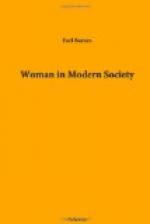So far we have taken the popular position, and have discussed this matter as though it were still in the period of debate. The fact is, it long ago passed from the field of theory; it is now a condition. In six of our States, women have now full participation in managing public affairs. In Wyoming, since 1869; in Colorado, since 1893; in Idaho, since 1896; in Washington, beginning in 1910; and in California, since 1911, women have been sharing the vote with men. In twenty-nine States they have school suffrage, and in many places municipal suffrage.[47] In newer parts of the world, like New Zealand and Australia, women have complete suffrage, while in old countries, like Norway, Sweden and Finland, they have essentially all the rights of men. In England, there are 1,141 women on Boards of Guardians and 615 on Educational Committees; and they are demanding full participation in all political life. In Canada they have school and municipal suffrage. It is no longer a time for argument; it is time for adjustment.
[47] BERTHA REMBAUGH, The Political Status of Women in the United States, G.P. Putnam’s Sons, 1912, gives complete information to date.
Meantime the results of woman’s full participation in political life, even where they have had the suffrage for some years, are difficult to determine, because of the fact already pointed out that political life in a modern democracy is so closely bound up with all the other life about it. It is quite as difficult to estimate these effects as it would be to estimate the effects of housekeeping or of woman’s special costume. And yet some results are clear enough to have a large bearing on the extension of woman’s suffrage in new localities.
In 1906, the Collegiate Equal Suffrage League engaged Miss Helen Sumner to make a careful study of the actual working of equal suffrage in the State of Colorado. Miss Sumner, aided by several assistants, spent nearly two years in the investigation. She gathered and carefully analyzed written answers to an extended set of questions from 1,200 representative men and women of Colorado, some opposing and some favoring equal suffrage; and she and her assistants interviewed many more. They also made a general study of industrial conditions and of legislation for the State as a whole, and a detailed study of election records and newspaper files for representative cities and counties. Her report is a masterpiece of patient research and scientific exposition.[48]
[48] HELEN L. SUMNER, Equal Suffrage. The Results of an Investigation Made in Colorado for the Collegiate Equal Suffrage League of New York State. New York: Harper & Bros., 1909.
Equal suffrage goes back to 1893 in Colorado; and while the influence of women has been in no way revolutionary, this report shows that, on the whole, political conditions have improved and woman’s intelligence and her general public spirit have increased with no appreciable loss in distinctive feminine charm. One cannot help feeling as one reads this report that it is what a disinterested observer would have to say about the effect of woman’s larger educational or industrial life since 1870.




